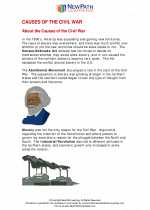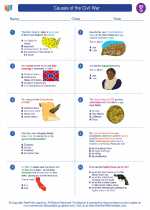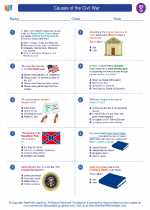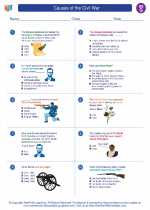Causes of the Civil War
In the 1800's, America was expanding and gaining new territories. The issue of slavery was everywhere and there was much conflict over whether or not the new territories should be slave states or not. Read More...
◂Social Studies Worksheets and Study Guides Seventh Grade. Causes of the Civil War
Study Guide Causes of the Civil War
Causes of the Civil War  Worksheet/Answer key
Worksheet/Answer key Causes of the Civil War
Causes of the Civil War  Worksheet/Answer key
Worksheet/Answer key Causes of the Civil War
Causes of the Civil War  Worksheet/Answer key
Worksheet/Answer key Causes of the Civil War
Causes of the Civil War 

 Worksheet/Answer key
Worksheet/Answer key
 Worksheet/Answer key
Worksheet/Answer key
 Worksheet/Answer key
Worksheet/Answer key

The resources above cover the following skills:
National Curriculum Standards for Social Studies (NCSS)
TIME, CONTINUITY, AND CHANGE
SOCIAL STUDIES PROGRAMS SHOULD INCLUDE EXPERIENCES THAT PROVIDE FOR THE STUDY OF THE PAST AND ITS LEGACY.
KNOWLEDGE - Learners will understand:
Concepts such as: chronology, causality, change, conflict, complexity, multiple perspectives, primary and secondary sources, and cause and effect.
National Standards for Civics and Government (NSCG)
What are the foundations of the American political system? What are the distinctive characteristics of American society?
Distinctive characteristics of American society. Students should be able to identify and explain the importance of historical experience and geographic, social, and economic factors that have helped to shape American society. To achieve this standard, students should be able to
Explain important factors that have helped shape American society
A history of slavery
Diversity in American society. Students should be able to evaluate, take, and defend positions on the value and challenges of diversity in American life. To achieve this standard, students should be able to
Explain why conflicts have arisen from diversity, using historical and contemporary examples, e.g., North/South conflict; conflict about land, suffrage, and other rights of Native Americans; Catholic/Protestant conflicts in the nineteenth century; conflict about civil rights of minorities and women; present day ethnic conflict in urban settings
What are the foundations of the American political system? What is American political culture?
The character of American political conflict. Students should be able to describe the character of American political conflict and explain factors that usually prevent violence or that lower its intensity. To achieve this standard, students should be able to
Describe political conflict in the United States both historically and at present, such as conflict about
Geographic and sectional interests
Slavery and indentured servitude
Engaging in wars
What are the foundations of the American political system? What values and principles are basic to American constitutional democracy?
Disparities between ideals and reality in American political and social life. Students should be able to evaluate, take, and defend positions on issues concerning ways and means to reduce disparities between American ideals and realities. To achieve this standard, students should be able to
Describe historical and contemporary efforts to reduce discrepancies between ideals and the reality of American public life, e.g., abolition, suffrage, civil rights, and environmental protection movements
How does the government established by the constitution embody the purposes, values, and principles of American democracy? How does the American political system provide for choice and opportunities for participation?
Associations and groups. Students should be able to explain how interest groups, unions, and professional organizations provide opportunities for citizens to participate in the political process. To achieve this standard, students should be able to
Describe the historical roles of prominent associations and groups in local, state, or national politics, e.g., abolitionists, suffragists, labor unions, agricultural organizations, civil rights groups, religious organizations
What are the roles of the citizen in American democracy? How can citizens take part in civic life?
Forms of political participation. Students should be able to describe the means by which Americans can monitor and influence politics and government. To achieve this standard, students should be able to
Describe historical and current examples of citizen movements seeking to promote individual rights and the common good, e.g., abolition, suffrage, labor and civil rights movements
National Center for History in Schools (NCHS)
Historical Thinking Standards
Historical Comprehension
Reconstruct the literal meaning of a historical passage.
Historical Analysis and Interpretation
Analyze cause-and-effect relationships and multiple causation, including the importance of the individual, the influence of ideas.
United States History Content Standards
Era 4: Expansion and Reform (1801-1861)
United States territorial expansion between 1801 and 1861, and how it affected relations with external powers and Native Americans.
The student understands the ideology of Manifest Destiny, the nation's expansion to the Northwest, and the Mexican-American War.
How the industrial revolution, increasing immigration, the rapid expansion of slavery, and the westward movement changed the lives of Americans and led toward regional tensions.
The student understands the rapid growth of "the peculiar institution" after 1800 and the varied experiences of African Americans under slavery.
The extension, restriction, and reorganization of political democracy after 1800.
The student understands how the debates over slavery influenced politics and sectionalism.
The sources and character of cultural, religious, and social reform movements in the antebellum period.
The student understands the abolitionist movement.
The student understands how Americans strived to reform society and create a distinct culture.
Era 5: Civil War and Reconstruction (1850-1877)
The causes of the Civil War.
The student understands how the North and South differed and how politics and ideologies led to the Civil War.
The course and character of the Civil War and its effects on the American people.
The student understands how the resources of the Union and Confederacy affected the course of the war.
The student understands the social experience of the war on the battlefield and homefront.
World History Content Standards
Era 7: An Age of Revolutions, 1750-1914
The causes and consequences of the agricultural and industrial revolutions, 1700-1850.
The student understands the causes and consequences of the abolition of the trans-Atlantic slave trade and slavery in the Americas.
Patterns of nationalism, state-building, and social reform in Europe and the Americas, 1830-1914.
The student understands the political, economic, and social transformations in the Americas in the 19th century.